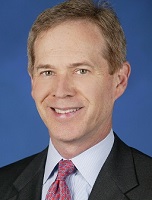Next TV: Microsoft's Westlake: TV Industry Faces Innovator’s Dilemma

San Francisco - Microsoft corporate vice president of the Media and Entertainment Group Blair Westlake, during a keynote address at the Next TV Summit here on Sept. 11, discussed the rapidly changing technology landscape facing the TV industry by comparing it to the classic "innovator’s dilemma."
“When you have a good thing that is making for money for you,” there is a tendency by companies to think that “if it ain’t broke don’t try to fix,” Westlake said. “But when you realize it may not be broke but that the pencil is being stretched to the point where it is about to snap,” then companies have to change.
One example of successful change, he noted, was Netflix, which had a very lucrative traditional DVD rental in the mid-2000s. But executives saw the decline in the DVD business and shifted to become a pioneer in streaming video. "They are the best example of seeing what is coming and moving their business model before the pencil snapped," he said. "In four years they've gone from zero digital subscribers to 30 million. HBO was launched 35 years ago, and today they are also at roughly 30 million subscribers."
TV companies in all aspects of the business—from pay TV operators to broadcasters—also face the classic “innovators dilemma,” where the current business models are still performing, but the under pressure. “Every one of these players has a business model that is being pushed and pulled and under stress in a way that no industry has faced, including music industry,” he said.
One major area ripe for change was traditional distribution models, which Westlake noted were under threat as cord-cutting accelerates and younger demos embrace new ways of accessing content.
“There has been a view that when the younger generation grows up, they will do what their parents did,” said Westlake. “But the numbers suggest otherwise. We have a generation that is getting content whenever it is convenient. It is generation that has migrated off email to text and is less inclined to watch TV programming on a TV.”
But change in this area would likely be complicated by rights issues and the need to maintain some majorrevenue from pay TV operators. As a result, he predicted that a “sizable portion” of the population will continue to subscriber to traditional pay TV services.
The smarter way to stay on top of the multichannel video marketplace. Sign up below.
But he added that some companies like Disney/ABC with its Watch ABC app are starting to launch services to deliver services that target the video consumption patterns of younger viewers.
Over time, this will cause new windows and distribution models to emerge, he explained. Pointing to the addition of new windows over the last 30 years for cable, premium cable, DVD, VOD and most recently subscription video on demand services like Netflix, he said “the salami will be sliced in more and more ways.”
Westlake received a Digital Leadership Award at the Next TV Summit, hosted by Broadcasting & Cable and Multichannel News on Sept. 10 and 11.
